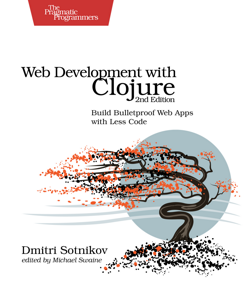Adding custom middleware
Since Luminus uses Ring for routing, the application handler is a standard Ring handler and can be wrapped in middleware just like you would in any other Ring based application.
The middleware allows wrapping the handlers in functions which can modify the way the request is processed. Middleware functions are often used to extend the base functionality of Ring handlers to match the needs of the particular application.
A middleware is simply a function which accepts an existing handler with some optional parameters and returns a new handler with some added behaviour. An example of a middleware function would be:
(defn wrap-nocache [handler]
(fn [request]
(let [response (handler request)]
(assoc-in response [:headers "Pragma"] "no-cache"))))
As you can see the wrapper accepts the handler and returns a function which in turn accepts the request. Since the returned function was defined in the scope where the handler exists, it can use it internally. When called, it will call the handler with the request and add Pragma: no-cache to the response map. For detailed information please refer to the official Ring documentation.
The middleware is added in the middleware namespace of your project. The wrap-base function aggregates all the common middleware for the application. Only add middleware that you also wish to use in production in the wrap-base function.
(defn wrap-base [handler]
(-> ((:middleware defaults) handler)
wrap-formats
wrap-webjars
wrap-flash
(wrap-session {:cookie-attrs {:http-only true}})
(wrap-defaults
(-> site-defaults
(assoc-in [:security :anti-forgery] false)
(dissoc :session)))
wrap-context
wrap-internal-error))
Any development middleware, such as middleware for showing stacktraces, should be added in the wrap-dev function found in the <app>.dev-middleware namespace. This namespace resides in the env/dev/clj source path and will only be included during development mode.
(defn wrap-dev [handler]
(-> handler
wrap-reload
wrap-error-page
wrap-exceptions))
Note that the order of the middleware matters as the request is modified by each middleware function. For example, any middleware functions that rely on the session must be placed before the wrap-defaults middleware that creates the session. The reason being that the request will pass through the outer middleware functions before reaching the inner ones.
For example, when we have the handler wrapped using wrap-formats and wrap-defaults as seen below:
(-> handler wrap-formats wrap-defaults)
The request is passed through these functions in the following order:
handler <- wrap-formats <- wrap-defaults <- request
Useful ring middleware
- ring-ratelimit - Rate limiting middleware
- ring-etag-middleware - Calculates etags for ring responses and returns 304 responses when appropriate
- ring-gzip-middleware - Gzips ring responses for user agents which can handle it
- ring-upload-progress - Provide upload progress data in ring session
 Luminus
Luminus
